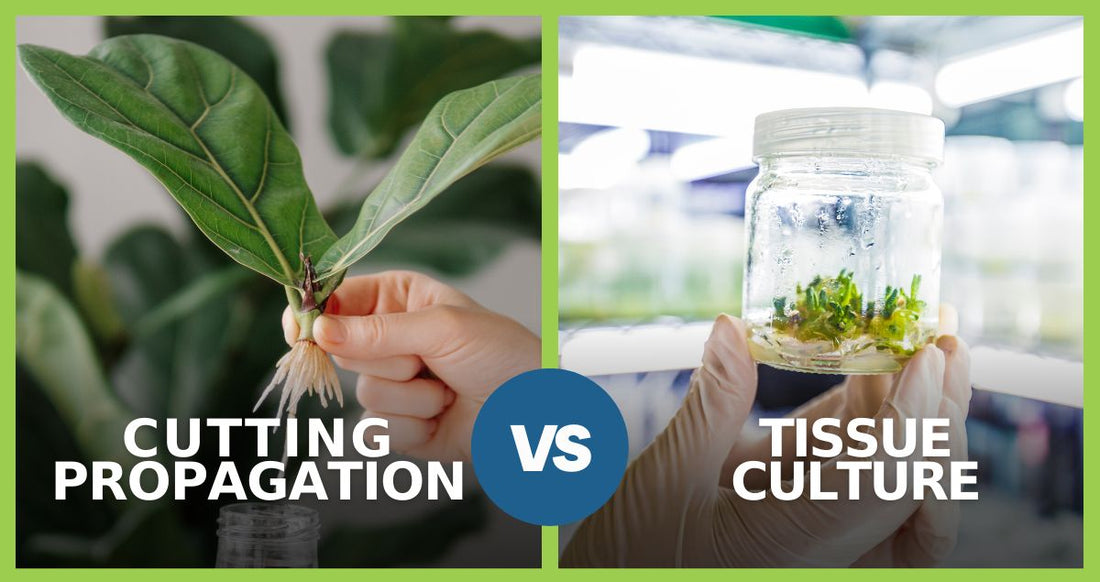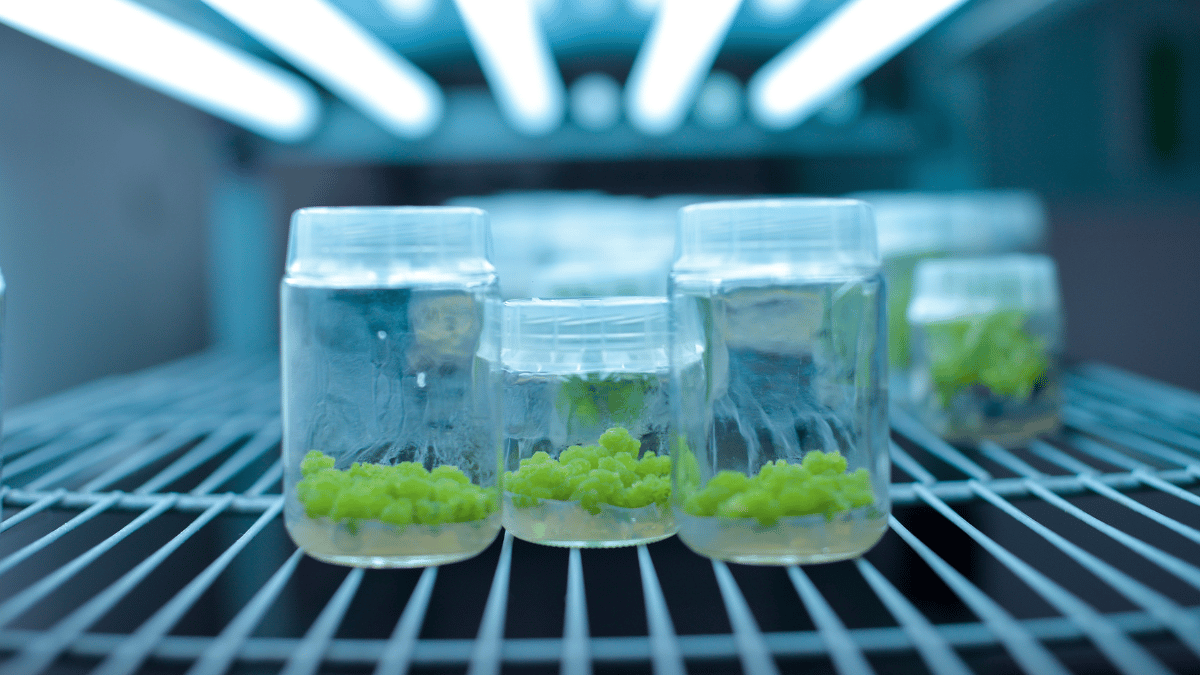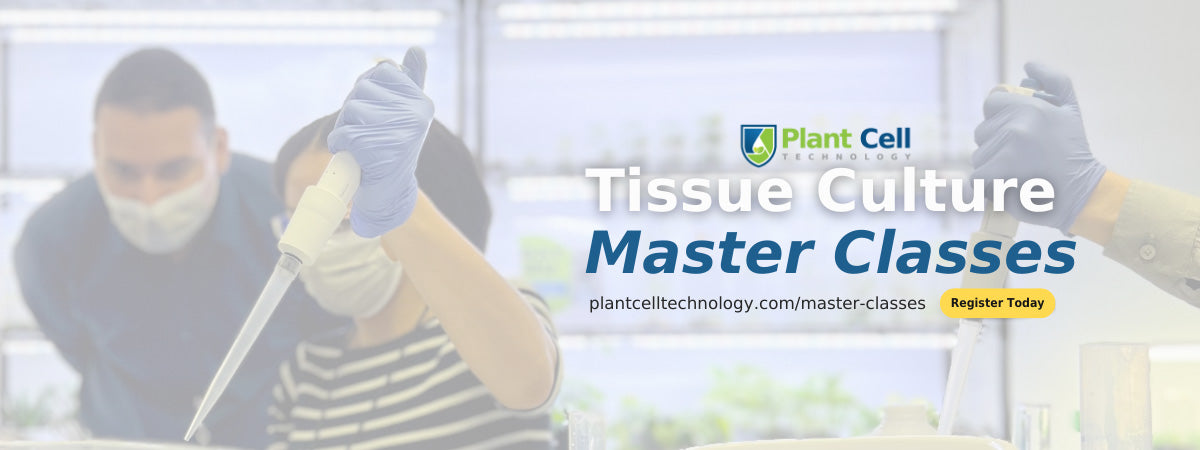
Why Is Tissue Culture Better Than Plant Cuttings?
As a content and community manager, I leverage my expertise in plant biotechnology, passion for tissue culture, and writing skills to create compelling articles, simplifying intricate scientific concepts, and address your inquiries. As a dedicated science communicator, I strive to spark curiosity and foster a love for science in my audience.


Introduction
Plant propagation has evolved beyond traditional methods of using cuttings or seeds, with advanced technologies such as hydroponics, aeroponics, and tissue culture now dominating the field. Among these, tissue culture emerges as a unique and highly effective approach to plant propagation, capable of growing any desired plant using just a few tissues to regenerate an entire plant.
You might wonder why there's a need for these advanced techniques when traditional methods like cuttings have been in use for ages. While cutting requires only a portion of the plant for regeneration and seems less complex, there are challenges associated with this approach that outweigh its advantages.
In this article, we delve into the comparisons between cutting and tissue culture techniques, highlighting how the latter, despite requiring more expertise, proves to be a more effective and beneficial approach, especially for commercial plant growers.

Cutting: The Traditional Plant Propagation Technique
Multiple traditional techniques are known so far to grow plants including cutting, grafting, division, layering, and through seeds. These techniques have been in practice for about 8000-10000 years.
Cutting is a technique where a healthy part of the plant, such as the stem, root, or leaf, is trimmed and placed in water or a growing medium for the development of the root or stem before planting it in the soil. This is an easy method of multiplying plants that we have known for decades.
The advantages of the technique include:
- Production of a plant identical to the parent plant, while also keeping special characteristics of the plant.
- Cutting is beneficial to grow plants that take two to three years to produce seeds. You can multiply such plants by taking their cutting, without waiting for the seeds.
- Plants grown from cuttings mature and flower faster than a plant that’s grown using seeds.
Based on the part of the plant involved in the process, the cutting technique is of different types:
- Stem cutting: In this process, a healthy stem with a few leaves is trimmed off from a healthy plant and grown in a medium for root development. This approach works mostly for the herbaceous and softwood plants. Cuttings taken during different parts of the year show different root development abilities.
- Leaf-cutting: Only a few plant leaves have the ability to regenerate plant organs. In this process, a whole leaf is taken from a healthy plant and placed on a suitable media for the development of root and stem. As soon as a new plant is formed, the leaves used to grow it disintegrate and are no longer part of the plant.
- Root cutting: Here, root cutting is taken from the plants for the regeneration of a whole new plant. The root cuttings are taken when the plant is dormant and the roots are the only organ with the most stored energy. However, only a few plant species can be grown using this method.

Tissue Culture: Growing Plants In Jars Using a Few Pieces of Tissue
Tissue culture or micropropagation is an advanced technique to grow plants. In this method, a few pieces of tissue are taken from a healthy part of the plant and placed on an artificial nutrient media for the regeneration of a plant in a complete artificial condition.
Brief History
The concept of tissue culture stems from the notion of totipotency, which refers to the capability of any plant cell to develop into an entire plant—a fundamental property of plant cells. The idea was proposed in 1902 by Gottlieb Haberlandt.
However, it wasn't until the 1930s and 1940s that the discovery of plant growth regulators paved the way for major breakthroughs. Over the years, techniques like cell suspension cultures and callus cultures were refined. The 1970s and 1980s brought biotechnology into the picture, allowing genetic manipulation within tissue culture. From the 1990s onward, molecular biology and genetic engineering have continued to be used with plant tissue culture, making it a vital tool in agriculture and biotechnology, contributing to plant breeding and crop improvement.
As of today, the applications of tissue culture expanded to several different areas, including:
- In vitro propagation of a number of vegetables, cereals, fruit, and ornamental plants.
- Long-term storage of plants through cryopreservation technology.
- Utilizing bioreactors for automated cell culture in the production of secondary compounds.
- Understanding the somatic embryogenesis and organogenesis techniques.

Types of Tissue Culture Technique
Based on the explant or starting material used to induce plant growth, the tissue culture technique is of different types:
- Callus Culture: Callus culture is a tissue culture technique where the undifferentiated, mass of cells, known as a callus, is developed from plant tissues. This callus can then be further induced to differentiate into various cell types and eventually form roots, shoots, or whole plants under controlled conditions.
- Meristem Culture: It’s a method where meristematic tissues are used as an explant for the regeneration of a whole plant. It’s an effective method to produce disease-free plants.
- Embryo Culture: Embryo culture is a technique in tissue culture that involves the isolation and cultivation of immature or mature plant embryos in an artificial environment.
- Protoplast Culture: Protoplast culture is a technique in tissue culture that involves isolating and cultivating plant protoplasts (cells without their cell walls) in a controlled environment.
- Anther/Pollen Culture: Pollen/anther culture is a plant biotechnology technique that entails isolating and cultivating pollen grains or anthers (the male reproductive parts of flowers) in a nutrient-rich medium. This method facilitates the development and regeneration of haploid plants or callus tissues from cultured pollen or anther cells.
- Ovary Culture: It’s a tissue culture technique where fertilized or unfertilized ovaries of plant species are cultured in a suitable environment to regenerate a new plant.
- Seed Culture: Seed culture is a tissue culture method used for cultivating various plants, including orchids, in a lab setting using seeds as the starting material.

Cutting Vs Tissue Culture
As you now know the tissue culture and cutting techniques are two very different techniques. While one is a traditional approach to growing plants known for centuries, the other is an advanced approach that originated in the 1920s.
- Cutting heavily relies on the environmental conditions in the location where the cutting is planted. External factors like temperature, humidity, and light influence the success of cutting propagation. Tissue culture involves precise control of environmental conditions in a lab, regulating factors like temperature, light, and nutrient levels for the proper growth and development of plants with greater success.
- Cutting is typically a slower propagation method compared to tissue culture as it involves the gradual development of roots and subsequent growth. In contrast, tissue culture allows for rapid propagation, enabling the production of multiple plants from a small piece of tissue in a relatively short time.
- Cutting is susceptible to diseases and pathogens in the soil, and the health of the new plant can be influenced by external factors. On the other hand, tissue culture starts in a sterile environment, significantly reducing the risk of diseases, and the plants produced are initially free from soil-borne pathogens.
- Cutting is a frequently employed method for various plants, especially those with easily rootable stems. On the other hand, tissue culture proves particularly beneficial for plants that pose challenges for propagation through conventional means or when there is a requirement for large-scale production of genetically uniform plants.
- While cutting requires less expertise, facility, and equipment and is a cost-effective approach for propagating plants, however, tissue culture is more sophisticated laboratory equipment and techniques, requiring specialized knowledge and skills. Further, it’s also a costly procedure, which restricts its use to growers with limited finances.
How Is Plant Cell Technology Helping Culturists?

Both, tissue culture technique and plant cutting techniq have their advantages and disadvantages. However, if you have a substantial budget in your hand, you can create a decent tissue culture facility to utilize the advanced technique for increased profit. If you are a commercial grower, tissue culture is the technique you should go for, however, as a hobbyist you might prefer the cutting approach.
If you choose to do tissue culture, Plant Cell Technology is revolutionizing the industry with its exceptional products and services designed to streamline your workflow. From essential items like MS media, agar, gellan gum, Plant Preservative Mixture™ (PPM™), culture vessels, and Biocoupler™ to masks, we have everything you need in our store.
But that's not all! We go beyond just providing materials; our consultation services are here to offer instant solutions to your tissue culture challenges. If you're eager to enhance your skills directly from an expert, our comprehensive tissue culture master classes are tailored for you.
These classes cover everything from fundamental concepts to hands-on experiences, including explant and media preparation, multiplication, rooting, and acclimation of plants. Moreover, advanced techniques like shoot apical meristem and synthetic seed production are also part of the curriculum, ensuring you become a proficient player in the industry.
Taught by tissue culture experts with 10-30 years of experience, our masterclasses not only educate you on tissue culture concepts but also share personal success and failure stories, offering valuable insights for your journey.
Excited to take your tissue culture skills to the next level? Don't wait any longer! Sign up for your preferred tissue culture master class today and elevate your expertise in the field!
Blog Categories
View by Level
Popular Blogs

Callus Culture: Definition and Applications
Introduction Tissue culture is not just one technique! Yes, you heard right! As you know, tissue culture is an advanced...
Read More
6 Plant Tissue Culture Books to Keep Learning
Introduction Most of us are fans of books when it comes to learning a topic in detail and in a...
Read MoreSubscribe to Our Newsletter








Join the conversation
Your email address will not be published. Required fields are marked